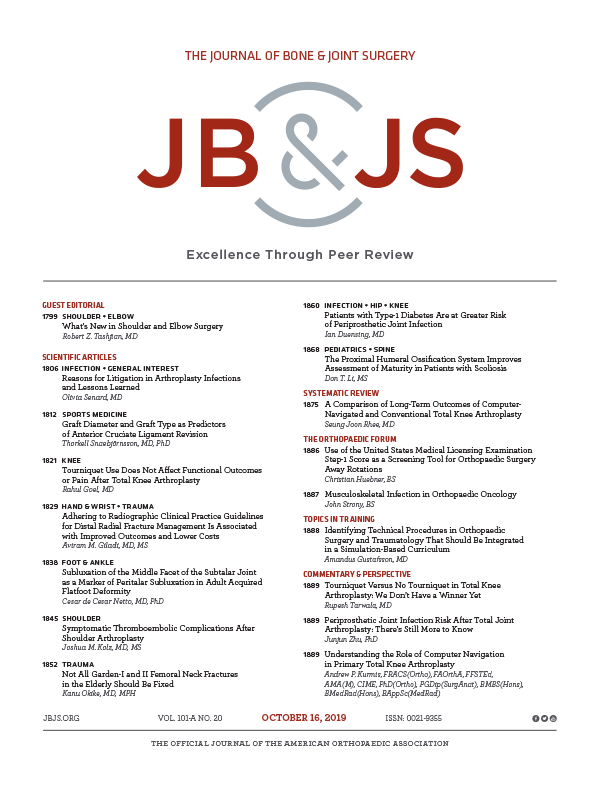
Better finger motion with active place-and-hold therapy after zone II flexor tendon repair

Better finger motion with active place-and-hold therapy after zone II flexor tendon repair
Zone-II flexor tendon repair: a randomized prospective trial of active place-and-hold therapy compared with passive motion therapy
J Bone Joint Surg Am. 2010 Jun;92(6):1381-9.Synopsis
103 patients (age range 15-75) with 119 digits undergoing zone-II flexor tendon repairs within 48 hour of injury by Strickland four-strand tendon repair technique were randomized to post surgical rehabilitation methods of either active or passive motion therapy. At 1 year, digit range of motion was significantly greater with smaller flexion contracture and higher satisfaction scores in patients receiving active motion therapy versus passive motion therapy. However, patient-assessed outcomes (DASH Score) and dexterity did not prove to be any different between the groups.
Was the allocation sequence adequately generated?
Was allocation adequately concealed?
Blinding Treatment Providers: Was knowledge of the allocated interventions adequately prevented?
Blinding Outcome Assessors: Was knowledge of the allocated interventions adequately prevented?
Blinding Patients: Was knowledge of the allocated interventions adequately prevented?
Was loss to follow-up (missing outcome data) infrequent?
Are reports of the study free of suggestion of selective outcome reporting?
Were outcomes objective, patient-important and assessed in a manner to limit bias (ie. duplicate assessors, Independent assessors)?
Was the sample size sufficiently large to assure a balance of prognosis and sufficiently large number of outcome events?
Was investigator expertise/experience with both treatment and control techniques likely the same (ie.were criteria for surgeon participation/expertise provided)?
Yes = 1
Uncertain = 0.5
Not Relevant = 0
No = 0
The Reporting Criteria Assessment evaluates the transparency with which authors report the methodological and trial characteristics of the trial within the publication. The assessment is divided into five categories which are presented below.
3/4
Randomization
3/4
Outcome Measurements
4/4
Inclusion / Exclusion
4/4
Therapy Description
3/4
Statistics
Detsky AS, Naylor CD, O'Rourke K, McGeer AJ, L'Abbé KA. J Clin Epidemiol. 1992;45:255-65
The Fragility Index is a tool that aids in the interpretation of significant findings, providing a measure of strength for a result. The Fragility Index represents the number of consecutive events that need to be added to a dichotomous outcome to make the finding no longer significant. A small number represents a weaker finding and a large number represents a stronger finding.
Why was this study needed now?
Zone-II flexor tendon injuries often require intensive hand therapy due to high risk of loss of full active digit motion, stiffness, and interphalangeal joint contractures. A structured rehabilitation program with components of extension block splinting, active extension against a rubber band, and passive flexion has been meticulously designed to prevent these complications. The passive motion protocol had improved clinical results compared to immobilization. No randomized trials have examined the potential differences between the passive and active motion therapy. This study compared the two motion therapies after a zone II combined repair of the flexor digitorum profundus and the flexor digitorum superficialis.
What was the principal research question?
Does active motion therapy provide better finger motion than passive motion therapy for zone-II flexor tendon injuries?
What were the important findings?
- Patients that underwent active motion therapy had significantly better ROM, as compared to patients that underwent passive motion therapy at all time points of 6, 12, 26, and 52 week (p<0.05).
- Average ROM in active group was 122+/-16 at 6 weeks, improving to 156+/-25 at 52 weeks. Average ROM in passive group was 82+/-14 at 6 weeks, improving to 128+/-22 at 52 weeks (p<0.05).
- Proximal and distal interphalangeal joint flexion contractures were significantly greater in the passive motion therapy at each time point (42+/-19 at six weeks and improved to 28+/-13 by fifty-two weeks) compared to 27 +/- 12 at six weeks and improved to 15+/-8 by 52 weeks with active motion therapy (p<0.05).
- At 1 year, average DASH score between groups was not significantly different (2.0+/-3.7 for the active motion group and 3.1+/-4.3 for the passive group; p=0.09), however the average satisfaction score was significantly greater for the active motion group than for the passive motion group (p < 0.05).
- No significant differences were found between groups for dexterity testing with the Jebsen-Taylor and Purdue Pegboard score at 52 week.
- The flexion contractures were lesser in patients with single digit injuries than those with multiple digit injuries (p < 0.05) .
- There were 2 tendon ruptures in each group.
- Smoked had lesser mean combined flexion (130+/-9 compared with 146+/-18), as well as larger mean flexion contractures (26+/-6 compared with 17+/-11) than non-smokers regardless of the rehabilitation protocol (p < 0.05).
- The active motion group returned to full-duty work without restrictions at an average of 82 days (range 68-94) compared to average of 103 days (range 76-126) for patients in the passive motion group (p < 0.05).
What should I remember most?
Digit ROM at all time points (up to a year) was significantly better in zone-II tendon repair patients receiving active motion therapy versus passive motion therapy. However, patient-assessed outcomes (DASH) and dexterity testing were no different between the groups at 1 year. Post-hoc testing compromises the internal validity of the study.
How will this affect the care of my patients?
In patients that have sustained zone II tendon injuries requiring repair, early active motion therapy is beneficial in improving ROM and reducing contractures, compared to passive motion therapy. This study findings encourage early active motion for rehabilitation of zone II tendon repairs.
Learn about our AI Driven
High Impact Search Feature
Our AI driven High Impact metric calculates the impact an article will have by considering both the publishing journal and the content of the article itself. Built using the latest advances in natural language processing, OE High Impact predicts an article’s future number of citations better than impact factor alone.
Continue



 LOGIN
LOGIN

Join the Conversation
Please Login or Join to leave comments.